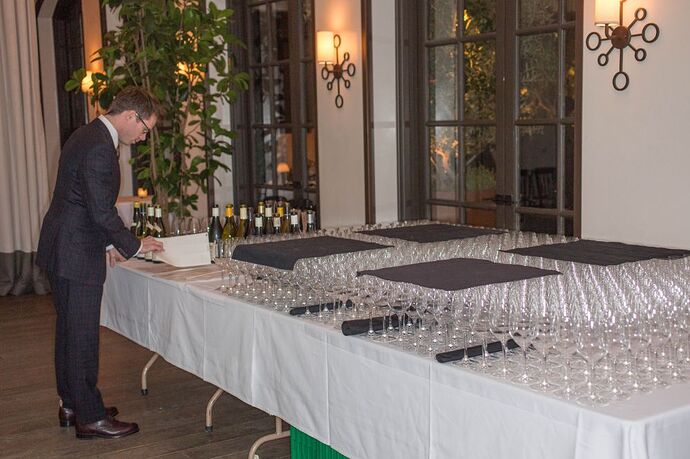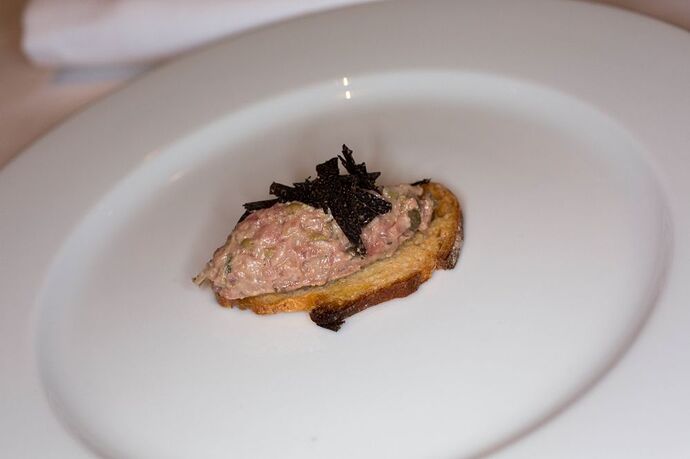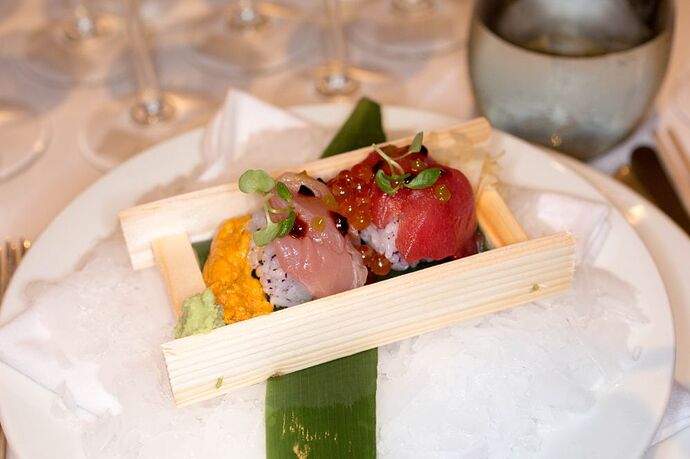Part I – February 5, 2013 at Spago Restaurant, Beverly Hills CA
26 top-rated Chablis, Meursault and Corton Charlemagne from the 2005 vintage
As most of you already know, each year I host a series of Vintage Assessment and “Premox” Check Dinners in Los Angeles at which we comprehensively taste a single vintage of white burgundies at 7.5 years of age over three nights. We usually taste 60 to 65 of the very top wines of the vintage from the Chablis and the Cote de Beaune. This year, the eighth consecutive year for these dinners, we’re tasting the 2005 vintage whites.
The first installment of our 2005 Vintage Assessment dinners was held at Spago Restaurant in Beverly Hills on Tuesday February 5, 2013. This was our first return to Spago since our February 2011 retrospective 1990-2000 Chablis dinner. Once again we were dazzled by the food and artistry of Chef-Owner Wolfgang Puck, Executive Chef, Lee Hefter, Chef de Cuisine Tetsu Yahagi, Pastry Chef Sherry Yard and sommelier Chris Miller. Trust me when I say that the food tasted every bit as good as the photos below make it appear. The appetizers here are always fun. Each course was fabulous and, with a minor quibble here and there, matched very well with the wines in each flight. Wolfgang stopped in himself to say hi to everyone and make sure we were enjoying the food.
On night two, which will be held at Valentino Restaurant in Santa Monica on February 20, 2013, we will taste 26 or more grand crus from the hyphenated Montrachet vineyards. On our final night, February 27, 2013, we will hold the annual “Mostly Montrachet” dinner at Melisse Restaurant.
These dinners are always huge undertakings, both in the organization and the execution of the event. For example, here’s Spago’s Sommelier Chris Miller preparing all of the glasses and the wines for the dinner:
This photo and the ones below were taken by Andrew Gavin, one of the attendees. Andy has several more photographs of the event on his own blog site, All Things Andy Gavin: Spago – 2005 White Burg part 1! :: All Things Andy Gavin)
Appetizer Course
Hors D’oeuvres-Steak Tartar, Spago falafel with creme fraiche, Puff pastry with bacon, Spago Salmon Pizza
The Steak Tartare appetizer
1996 Egly-Ouriet Brut Grand Cru Vieilles Vignes Champagne (2 x 750ml)
Medium gold color; a slightly nutty and citrus, slightly oxidized style very much like Krug; this was a really nice champagne with a mix of green apple, citrus, toasty/nutty elements, nice balancing acidity and a really long somewhat minerally finish. A very, very nice Champagne to start us off. 95
Spago’s famous “Salmon Pizza” as an appetizer
1996 Pol Roger Gran Année Champagne
This was intended solely as a backup bottle but we ran out of champagne due to staggered arrivals and so we tried this with the appetizers. Very youthful light yellow-green color; light clean citrus and leechee fruit aromas; very youthful, light green apple/citrus flavors, seems thin and angular compared to the Egly-Ouriet. 91
Flight One - - Chablis
Chirasi Sushi: Blue Fin Tuna, Hamachi, Salmon Pearls, Sea Urchin
#1 2005 Raveneau Chablis Montee de Tonnerre
The initial bottle opened was badly corked. We had planned on not serving it, but Ron Greene had brought a backup bottle, so we used that one. Thus, this was the only wine which wasn’t served single blind. Bright yellow color; light gooseberry and lime aromas; light buttery texture-quite surprising for Chablis; some lemon-lime fruit and a lot of elegance; an unusual mix for a 7.5 year old Raveneau wine. Group Rank: Tied for 9th, 7 pts (0/0/0/3/1) 92
#2 [2005 Fevre Chablis Preuses]
Very light yellow color; light floral and citrus aromas; on the palate, this was fairly light, borderline dilute with green apple flavors with some glycerin background and a very modest stony element but not really much minerality. Pretty disappointing for grand cru Chablis from a major producer. Group Rank: Tied for 19th, 0 pts 90
#3 [2005 Raveneau Chablis Valmur]
Another wine with a very light yellow color; gooseberry and pear aromas; a slightly fruity (green apple/pear) mid-palate and very modest minerality on the finish with good acidity and a sense this could improve slightly. But this is clearly not classically-styled Chablis. Group Rank: Tied for 14th, 4 pts (0/1/0/0/0) 92+
#4 [2005 Fevre Chablis Clos]
Very light yellow color; aromas of white nectarine and gooseberry; on the palate this had the same white nectarine fruit and at least some modest minerality. Group Rank: Tied for 19th, 0 pts 92
#5 [2005 Dauvissat Chablis Clos]
Light gold color; pear and white flowers with a whiff of pineapple; on the aromas and the palate this was distinctly closer to Puligny than Chablis – pear fruit, with a much richer texture and more depth than the first four wines; no minerality at all here. Nice wine, but I’d never identify this as Chablis. Group Rank: Tied for 19th, 0 pts 93
#6 [2005 Raveneau Chablis Clos]
Medium yellow color, almost gold; some slightly toasty, smoky, and odd elements in the aromas I can’t quite place – a couple of tasters suggested it was reduction, but I don’t think so because there’s no sulfur apparent; this aroma dissipated somewhat with time but it was never quite right; but on the palate, this was a very charming wine – fat, forward, green apple fruit with surprisingly good acidity despite a glyceric texture and some minor minerality in the finish. If the aromas here are atypical, this bottle could actually improve with additional age. Group Rank: Tied for 12th, 5 pts (0/0/1/0/2) 93+?
#7 [2005 Dauvissat Chablis Preuses]
Medium yellow color, almost gold; distinct white flowers aromas; some light green apple fruit but underlying richness, decent acidity and some real oyster shell minerality here – albeit with much more fruit than usual; this was at least recognizable as Chablis (the only wine in the flight for which this was true), but it was a richer style than usual. Group Rank: Tied for 9th, 7 pts (0/1/1/0/0) 94
[N.B. I’m a Chablis fan but I found this flight extremely disappointing. Don’t let anyone tell you there’s the slightest comparison between 2002 and 2005 Chablis.]
Flight Two – Meursault Charmes and Genevrieres
“Uova da Raviolo” with Ricotta Cream, Parmesan, Black Truffle
#8 [2005 Colin-Morey Meursault Genevrieres]
Light yellow color; aromas of white honey and white nectarine; on the palate this was somewhat tight with good acidity, white nectarine flavors and some notable minerality and spearmint in the finish; this tasted younger than most of the wines in the flight. Excellent. My number 7 wine of the night. Group Rank: 7th, 10 pts (0/2/0/1/0) 94
#9 [2005 Mikulski Meursault Genevrieres]
Between light and medium gold color; beeswax and light sherry on opening, but the sherry character just kept on expnanding and ultimately made this undrinkable; on the palate, it was quite rich, but with a sweet/sour fruit and some sherry/whisky flavors. Strong consensus that this is completely oxidized. Group Rank: Tied for 19th, 0 pts [N.B. I had selected this wine based on good ratings from the critics and assurances from an MW friend in the UK that he’s never experienced an oxidized bottle of Mikulski. What’s worse, this bottle came directly from the Importer – Fine Vines in Chicago.] DQ-oxidized
#10 [2005 Henri Boillot Meursault Charmes]
Light gold color; clean green apple aromas; bright but relatively simple green apple flavors with some light minerality in the finish. Group Rank: Tied for 14th, 4 pts (0/1/0/0/0) 92
#11 [2005 Lafon Meursault Charmes]
Light gold color; green apple/pear and somewhat toasty aromas; on the palate this had some tart lemon-lime elements with some oddly advanced buttery elements mixed with minerals on the finish. Strong consensus that this wine was advanced. Group Rank: Tied for 19th, 0 pts 91-Advanced
#12 [2005 Roulot Meursault Charmes]
Light gold color; white flowers aromas; a richer, more concentrated Meursault with some lemon-lime flavors, some grilled nuts and lots of minerality; this was really massively concentrated wine compared to the rest of the flight; very nice long minerally finish. I’m guessing Lafon Charmes. Group Rank: 11th, 6 pts (0/0/0/2/2) 93
#13 [2005 Henri Boillot (Domaine) Meursault Genevrieres]
Light gold color; pear and citrus aromas; bright, pear and key lime with lots of minerals both on the mid-palate and the finish. Laser beam focus here. Truly outstanding wine. My number 3 wine of the night. Group Rank: 3rd, 21 pts (3/0/1/1/1) [N.B. In prior vintages this was bottled as Domaine Jean Boillot wine] 95
Flight Three – Meursault Perrieres
Black Bass with Crispy Scale, Littleneck Clams, Herb Coulis, Garlic Purée
#14 [2005 Matrot Meursault Perrieres]
Light gold color; very little detectable aroma – after considerable swirling some light pear hints; bright lemon custard fruit with modest minerals but a very odd, slightly hot alcoholic finish with some distinct bitterness; very strange for MP and obviously made from overripe grapes. Group Rank: Tied for 19th, 0 pts 88?
#15 [2005 Colin-Morey Meursault Perrieres]
Very light yellow color with hints of green; exotic aromas of lime citrus and a hard to place fruit ester; a very clean palate impression with lemon-lime fruit and a slight swell in breadth in the mid-palate and nice clean lemon custard and minerals finish. Very nice. My number 6 wine of the night. Group Rank: 2nd, 27 pts (1/4/2/0/0) 94
#16 [2005 Le Moine Meursault Perrieres]
Medium gold color; an odd brown spice aroma – almost cinnamon, like spice cake, and a peppery element; on the palate this had some citrus elements, buttery texture, good acidity and some modest minerals in the finish. There was essentially universal agreement that this wine was advanced. Group Rank: Tied for 19th, 0 pts 91?-Advanced
#17 [2005 Roulot Meursault Perrieres]
Very light gold color; brilliant pear and citrus aromas that burst out of the glass; tight lemon-lime fruit with intense, dominant minerality on both the mid-palate and the finish; the lemon-lime and minerals finish seemed to go on endlessly. A true WOW wine. My clearly favorite wine of the night. Roulot? Group Rank: 1st, 44 pts (5/3/1/2/0) 96
#18 [2005 Lafon Meursault Perrieres]
Between light and medium gold; oddly subdued aromas; on the palate this had some slightly tropical pineapple and buttery flavors in a rich style but with good acidity; a long slightly sweet citrus/pineapple finish; a very oddly styled wine for an MP [and a huge disappointment once this was revealed.] Group Rank: Tied for 19th, 0 pts 93?
Flight Four – Corton Charlemagne
Trio of Veal–Loin, Cheek, Tongue, Oven Roasted Maitake Mushrooms, Apple-Celery-Vanilla Purée, Confit Lemon Sauce
#19 [2005 Bouchard Corton Charlemagne]
Light gold color; citrus and fresh coconut and hints of toasty, oxidiative elements; sweet green apple fruit with a good degree of concentration and a very long fruity finish with light minerals. There was consensus that this wine was somewhat advanced – a shame because it is a powerfully concentrated Corton. Group Rank: 16th, 3 pts (0/0/1/0/0) 93-Advanced
#20 [2005 Jadot Corton Charlemagne]
Light gold color; sweet white flowers and green apple aromas; very rich green apple flavors, if a bit homogenous; long sweet apple flavors on the finish Group Rank: 8th, 9 pts (0/0/3/0/0) [NB This wine somehow avoided the usual oxidation problems that the post-1999 Jadots seem to suffer from] 93
#21 [2005 Girardin Corton Charlemagne Quintessence]
Light gold color; perfumed aromas of apple blossoms and midori liquer; immensely concentrated sweet green apple flavors but not so sweet as to be cloying; very long sweet fruit and minerals finish. The concentration here clearly exceeds everything else in the flight – reminiscent of Coche-Dury Corton, so I’m guessing that this is the Girardin Quintessence. My number five wine of the night. Group Rank: 6th, 12 pts (0/0/2/1/4). 94
#22 [2005 Bonneau du Martray Corton Charlemagne]
Light gold color; aromas of pear and green apple; the first impression is acidity and then some light green apple, but there doesn’t seem to be much depth here; simple green apple finish. Group Rank: 18th, 1 pt (0/0/0/0/1) 92
#23 [2005 Le Moine Corton Charlemagne]
Between light and medium gold color color; pear and green apple aromas and some more developed pastry elements; decent acidity; some rich apple pie flavors but the finish shows some definite alcohol. Despite the decent acidity, this seems fully mature and should be drunk up now before the alcoholic finish begins to dominate. Group Rank: Tied for 12th, 5 pts (1/0/0/0/0) 93
#24 [2005 Henri Boillot Corton Charlemagne]
Light gold color; minerally, lemon zest and green apple aromas; medium weight pear and green apple flavors with fabulous acidity and minerality; extremely long minerally finish. Impressive. My number 2 wine of the night. Group Rank Tied for 4th, 14 pts, (1/1/1/0/2) 95
#25 [2005 Montille Corton Charlemagne]
Light gold color; aromas of white honey and pear; definitely the lightest concentration in this flight with modest green apple/pear fruit and good acidity; nicely made, but to me this wine lacked the necessary weight/concentration to be a grand cru Corton and I’m pretty open to stylistic differences in Corton. (Group Rank: 17th, 2 pts (0/0/0/1/0) 92
#26 [2005 Colin-Morey Corton Charlemagne]
Light gold color; green apple aromas; this had notably dense green apple flavors with good acidity and a subtle layering in the mid-palate and a very minerally finish. Excellent. My number 4 wine of the night. Group Rank: Tied for 4th, (2/0/0/2/0) 94
Dessert Course
Passion, Pineapple, Mango. Rum Baba Boules. Passion Fruit Frozen Kumo. Oven Roasted Pineapples.
2001 Chateau De Fargues
As usual at these dinners, I didn’t pay enough attention to the dessert wine. This one had some carmelized pineapple and blood orange, considerable density/sweetness and good acidity. It worked extremely well with the dessert. My general impression was 94-ish.
Postscript statistics and comments:
Corked - 1/27 4% (Corked bottle of 05 Raveneau MDT replaced)
Oxidation -1/26 4%
Advanced -3/26 11.5%
Oxidized or advanced - 4/26 15.4%
If you’re a classical Chablis fan, you’re NOT going to like the 2005 Chablis vintage. With due respect to Steve Tanzer and Allen Meadows when they reviewed the Chablis back in 2007, they clearly overrated the 2005 Chablis. You have to work hard to find any of the usual markers of Chablis even among the handful of very top wines of the vintage. In 20/20 hindsight, it’s a vintage which, with maybe one or two exceptions, I wish I had not purchased because I don’t care for this style of Chablis.
A couple of things seemed pretty clear to me about the Cote de Beaunes. There is a good deal of sweetness in the fruit on these wines. You might even say that’s the most notable take away from the evening. The second thing was that the 2005 vintage is probably the most forward/ready to drink of any we’ve tasted in the last eight premox series. While the wines had adequate to good levels of acidity to balance the sweetness, the fruit tastes mature (and in a few cases past its prime). There wasn’t a single bottle from Meursault or Corton Charlemagne that I thought needed more time or would improve further with more time and there were a number of wines that were at or past or their peaks most of which I know had perfect provenance. It appears that Premox levels will be just as significant for this vintage as they were for 2002.
Thusfar, 2005 also appears to be a very producer-driven vintage. The wines from Boillot, Colin-Morey and Roulot were all excellent. The wines from Lafon and LeMoine were disappointing. I’m looking forward to night two.








